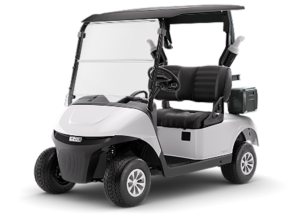US. ITC Investigation into Imports of Golf Car-Type Vehicles from China
The U.S. International Trade Commission and the Department of Commerce, based on the preliminary determination that there has been injury to the U.S. domestic industry, have launched an investigation into golf cars and subassemblies imported specifically from China. The official title of the investigation is “Low Speed Personal Transportation Vehicles from China”. The investigation numbers are 701-TA-731 and 731-TA-1700. (These numbers are useful to gain access to information on the progress of the investigation on the US ITC website, US.ITC.gov. )
ITC’s preliminary findings
This article presents an overview and analysis of some of the key concepts which underlie the investigation, as it has progressed so far. In particular, the ITC has published is preliminary report on its investigation. The result coming out of the preliminary report is that there is cause to believe that Chinese imports have been significantly subsidized by the Chinese government, such that they present a threat to the U.S. domestic industry because of the unfair competition resulting from these subsidies.
Petitioners in the complaint before the ITC are Club Car and E-Z-GO Textron, which in their collaboration have represented themselves as the American Low Speed Personal Transportation Vehicle Manufacturers Coalition. As noted, The Coalition was successful in their initial presentation to the ITC in that the Commission found, specifically, that, “On the basis of the record1 developed in the subject investigations, the United States International Trade Commission (“Commission”) determines, pursuant to the Tariff Act of 1930 (“the Act”), that there is a reasonable indication that an industry in the United States is materially injured by reason of imports of low speed personal transportation vehicles from China.”
Possible corrective actions
If, in its final investigation, which is now being undertaken, the Commission finds the petitioner’s allegations to be confirmed, then it can recommend two sorts of corrective actions: 1) Assess countervailing duties; and/or 2) Assess anti-dumping tariffs. In effect, both of these remedies would raise the landed price of Chinese vehicles and would likely result in dealers charging a higher price.
Two takeaways from the above, presuming they are imposed:
- Dealers are not compelled to raise prices and could take a hit on margins, while maintaining prices at the pre-tariff level to preserve market share;
- The corrective actions are aimed at units sourced from China and therefore could continue to be exported from other countries, with or without Chinese participation.
Analysis of the key topics in the ITC report
There are a number of other chapters in the ITC’s preliminary report which are important to analyze and critique.This article, however, continues to focus on the issue of product and industry definition. Other topics in the report will be addressed in future articles.
Product description/definition
In conducting interviews with dealers, when the question concerned PTV sales, the initial response was often, “What do you mean by a ‘PTV’?” It often came down to defining a PTV as any golf car-type vehicle not used for golf. Once this was clarified, the next question was, “Of the PTVs you sell, what percentage qualify for on-road used; that is, low-speed vehicles, so certified under NHTSA standards?” Fromm these responses SVR is able to distinguish clearly between three GCT type vehicles: Golf carts, PTVs, and LSVs.
The issue is not whether they are distinct types of vehicles, sold into different segments of the market, but rather the fact that the descriptive terminology is not yet fully developed. This is not surprising given the rather sudden emergence of the PTV/LSV market during and in aftermath of the COVID pandemic.
Contrary to these realities, the ITC uses a sweeping definition of the market, which it describes under a rubric of “domestic-like product”. Using this rubric, all GCT vehicles are subject to the investigation. The issue does not stop there.
Sources of product data
As we are looking at imports, it is logical to use the Department of Commerce’s HTS codes and the data collected under these codes as one of the main sources of data in order to determine market size (domestic production plus imports) and import penetration. The ITC identifies four HTS codes of interest:
- LSPTVs and other GCT vehicles enter under: 8703.10.5030 and 8703.90.0100;
- Subassemblies may enter under 8706.00.1540 or 8707.10.0040.
The ITC, however, dismisses these obvious sources, because they include a certain amount of product, such as other e-mobility product, that would not fall within the scope of the investigation.
Guidance given to SVR from the Department of Commerce, Bureau of the Census, which collects import data, identifies subassemblies packaged with all necessary components for final assembly, as a GCT vehicle. These, along with fully assembled units comprise GCT imports. As noted, the ITC’s reluctance to use this data source is that other types of vehicles, such as scooters and other e-mobility vehicles also come in under that HTS code. A way around this difficulty is to go to the customs records themselves, which contain a description of the product. Taking a sufficient sample of these records would likely reveal the degree to which these non-LSPTVs appeared in the data.
Implications for the market and product definition

Here are the implications of the product/market definition. First, the definition of the product and/or the market defines the scope of the investigation, which is critical.
If there is no segmentation of the market or the product flowing into the segments, then:
- The market is much broader, and it is more likely to find injury to domestic producers.
If the market is segmented into different classes of vehicles; e.g., golf carts vs. PTVs vs. LSVs, then:
- It is less likely to find injury and subsidization of Chinese products is irrelevant.

In the latter case, why are the subsidies a moot issue? The reason lies in the fact that petitioners (Club Car and E-Z-GO Textron) already dominate the golf cart segment, whereas the PTV/LSV segment is highly competitive. This, plus the fact that the two companies are certainly free to import subassemblies from China as well.
Conclusions so far
Petitioners claim that the market is a continuum of similar, or essentially similar products. This is largely based on the idea that the production process for a golf cart and a high-end LSPTV are pretty much the same. While that is by and large true, a golf cart or base model PTV are not equipped with LED lighting, four-wheel disk brakes, a back-up camera, turn signals, DOT certified windshield, windshield wipers, an audio system with Bluetooth, and an extended distance lithium battery pack, These differences show up in the price tag from $-$8,00 for the golf cart to over $20,000+ for the LSPTV.
No one buys a Bintelli Beyond model or a Tomberlin Engage—or for that matter, a Club Car lifted Onward–for exclusive, if any, use on the golf course. While the ITC admits to the wide range of uses and purposes, it seems to rest its case on the production process to invoke its sweeping definition of LSPTVs under the }domestic-like rubric.
The ITC’s preliminary findings are rich in detail for future analysis One could craft an entire microeconomics textbook around the product and market evolution that has taken place in this industry over the past 5-10 years. So, stay tuned.
________
Contact the Author: Steve Metzger at smetzger@smallvehicleresource.com. Or check out our website at www.smallvehicleresource.com, where you will find an extensive database of vehicle models and can make side-by-side comparisons of vehicles based on a full set of specifications.


